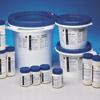TSI (gélose) / Triple Sugar Iron Agar - BD® Difco™
F/differentiation of gram-negative enteric bacilli based on carbohydrate fermentation...

|
Référence : 1122597
Unité de vente : 500 g
|
|
Pour différencier les organismes entériques Gram négatifs, basée sur leur capacité de fermentation du glucose, du dextrose, du lactose, du saccharose et de leur capacité de production de sulfures.
--------------------------------------------------------------------------
Triple Sugar Iron Agar (TSI Agar) is used for the differentiation of gram-negative enteric bacilli based on carbohydrate fermentation and the production of hydrogen sulfide.
Summary and Explanation
TSI Agar is used for the determination of carbohydrate fermentation and hydrogen sulfide production in the identification of gram-negative bacilli.
Hajna developed the formulation for TSI Agar by adding sucrose to the double sugar (dextrose and lactose) formulation of Kligler Iron Agar.
The addition of sucrose increased the sensitivity of the medium by facilitating the detection of sucrose-fermenting bacilli, as well as lactose and/or dextrose fermenters.
Carbohydrate fermentation is detected by the presence of gas and a visible color change (from red to yellow) of the pH indicator, phenol red. The production of hydrogen sulfide is indicated by the presence of a precipitate that blackens the medium in the butt of the tube.
Principles of the Procedure
TSI Agar contains three sugars (dextrose, lactose and sucrose), phenol red for detecting carbohydrate fermentation and ferrous ammonium sulfate for detection of hydrogen sulfide production (indicated by blackening in the butt of the tube).
Carbohydrate fermentation is indicated by the production of gas and a change in the color of the pH indicator from red to yellow. To facilitate the detection of organisms that only ferment
dextrose, the dextrose concentration is one-tenth the concentration of lactose or sucrose. The small amount of acid produced in the slant of the tube during dextrose fermentation oxidizes rapidly, causing the medium to remain red or revert to an alkaline pH. In contrast, the acid reaction (yellow) is maintained in he butt of the tube because it is under lower oxygen tension.
After depletion of the limited dextrose, organisms able to do so will begin to utilize the lactose or sucrose.
To enhance the alkaline condition of the slant, free exchange of air must be permitted by closing the tube cap loosely. If the tube is tightly closed, an acid reaction (caused solely by dextrose fermentation) will also involve the slant.
| Poids |
0,81 Kg (810 g) |
| Volume |
0,0056 m³ (5600 cm³) |
| Largeur |
0,15 m (15 cm) |
| Longueur |
0,15 m (15 cm) |
| Hauteur |
0,25 m (25 cm) |
Les dimensions, le poids et le volume sont bruts (emballage inclus)

 Retour aux résultats de la recherche
Retour aux résultats de la recherche Ajouter au panier
Ajouter au panier